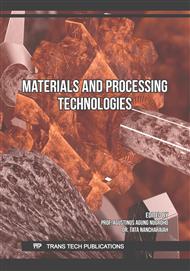[1]
W. D. Callister and D. G. Rethwisch, Materials science and engineering an introduction, tenth ed., Hoboken, NJ: John Wiley & Sons, Inc., 2018.
Google Scholar
[2]
C. Zweben, Composite Materials, first ed., John Wiley and sons, 2015.
Google Scholar
[3]
K. N. Keya, N. A. Kona, and F. A. Koly, Natural fiber reinforced polymer composites : history, types, advantages, and applications, Materials eng. research. 1 (2019) 69-85.
DOI: 10.25082/mer.2019.02.006
Google Scholar
[4]
Information on https://www.mar-bal.com/language/en/applications/history-of-composites/.
Google Scholar
[5]
S. Y. Fu, G. Xu, and Y. W. Mai, On the elastic modulus of hybrid particle/short-fiber/polymer composites, Compos. Part B Eng. 33 (2002) 291–299.
DOI: 10.1016/s1359-8368(02)00013-6
Google Scholar
[6]
M. M. The and K. Liao, Durability of bamboo-glass fiber reinforced polymer matrix hybrid composites, Compos. Sci. Technol. 63 (2003) 375–387.
DOI: 10.1016/s0266-3538(02)00225-7
Google Scholar
[7]
S. Mishra et al., Studies on the mechanical performance of bio fiber/glass reinforced polyester hybrid composites, Compos. Sci. Technol. 63 (2003) 1377-1385.
Google Scholar
[8]
M. J. John and S. Thomas,Bio fibers and biocomposites, Carbohydr. Polym. 71 (2008) 343–364.
Google Scholar
[9]
M. Boopalan, M. Niranjanaa, and M. J. Umapathy, Study on the mechanical properties and thermal properties of jute and banana fiber reinforced epoxy hybrid composites, Compos. Part B Eng. 51 (2013) 54–57.
DOI: 10.1016/j.compositesb.2013.02.033
Google Scholar
[10]
P. Noorunnisa Khanam, G. Ramachandra Reddy, K. Raghu, and S. Venkata Naidu, "Tensile, flexural, and compressive properties of coir/silk fiber-reinforced hybrid composites," J. Reinf. Plast. Compos. 29 (2010) 2124–2127.
DOI: 10.1177/0731684409345413
Google Scholar
[11]
O. Das, N. K. Kim, A. K. Sarmah, and D. Bhattacharyya, Development of waste-based biochar/wool hybrid biocomposites: Flammability characteristics and mechanical properties, J. Clean. Prod. 144 (2017) 79–89.
DOI: 10.1016/j.jclepro.2016.12.155
Google Scholar
[12]
P. Srivastava and S. Sinha, Effect of fiber hybridization on mechanical, thermal, and water absorption behavior of HF/CF/HDPE composites, Polym. Polym. Compos. 29 (2021) S882–S894.
DOI: 10.1177/09673911211027129
Google Scholar
[13]
G. Rajkumar, J. Srinivasan, and L. Suvitha, Development of novel silk/wool hybrid fiber polypropylene composites, Iran. Polym. J. (English Ed.). 22 (2013) 277–284.
DOI: 10.1007/s13726-013-0128-4
Google Scholar
[14]
H.N. Dhakal, F. Sarasin, C. Santulli, J. Tirillò, Z. Zhang, and V. Arumugam, Effect of basalt fiber hybridization on the post-impact mechanical behavior of hemp fiber reinforced composites, Compos. Part A Appl. Sci. Manuf. 75 (2015) 64–67.
DOI: 10.1016/j.compositesa.2015.04.020
Google Scholar
[15]
N.K. Kim, R.J.T. Lin, and D. Bhattacharyya, Flammability and mechanical behavior of polypropylene composites filled with cellulose and protein-based fibers: A comparative study, Compos. Part A Appl. Sci. Manuf. 100 (2017) 215–226.
DOI: 10.1016/j.compositesa.2017.05.017
Google Scholar
[16]
L. Yan, N. Chow, and K. Jayaraman, Flax fiber and its composites – A review, Compos. Part B Eng. 56 (2014) 296–317.
Google Scholar
[17]
J. Manivannan, S. Rajesh, K. Mayandi, and M. T. H. Sultan, Tensile and hardness properties of sheep wool fiber reinforced polyester composite, Mater. Sci. Forum. 969 (2019) 266–270.
DOI: 10.4028/www.scientific.net/msf.969.266
Google Scholar
[18]
S. M. Vinu Kumar, K. L. Senthil Kumar, H. Siddhi Jailani, and G. Rajamurugan, Mechanical, DMA and Sound Acoustic behavior of Flax woven fabric reinforced Epoxy composites Mater. Res. Express. 7 (2020) 53-69.
DOI: 10.1088/2053-1591/abaea5
Google Scholar


